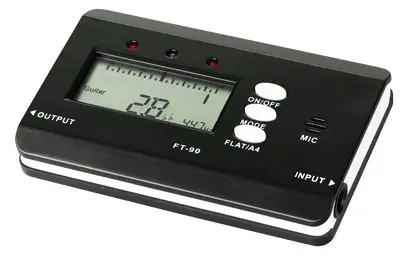For beginner guitarists, until they have gained the proper experience, it can be difficult to tune the guitar by ear. An excellent solution to this problem is to use a tuner. However, professional musicians also use tuners when it is necessary to quickly and silently tune the guitar, for example, at a concert. Tuners can be of different types, but the principle of operation is the same in all, the differences are only in the way of indication.

It is necessary
Guitar, tuner
Instructions
Step 1
Pick up a guitar. Place the tuner turned on near you. For example, on the knee. The idea is that the sound produced by the instrument can be heard by the tuner.
Step 2
Pull the first string of your guitar. Your tuner should respond to the sound you hear by changing the indicator.
Usually, the indicators display the name of the nearest note and the degree of its deviation from the nominal frequency value. If the indicator deviates to the right, then the string sounds higher than the nominal value and you need to loosen it. If to the left, then the string should be pulled up a little. Indicator deviations are sometimes indicated by # (sharp) and b (flat). Sharp means that the string needs to be loosened, flat means that the string needs to be pulled up.
This applies to cases where the string is slightly out of tune. Those. the indicator displays the name of the note to the pitch of which you want to tune the string. For example, in our case, the first string should sound like E notes. This note is designated by the letter E.
Step 3
Tune the string until the indicator shows E (E) and the indicator hand stops clearly in the middle. The sign E, denoting the notes mi, in a row of symbols is located between the signs D and F. The entire musical row is usually denoted by letters as follows: A (la), B (si) C (do), D (pe), E (mi), F (fa), G (salt). Sometimes the si sound is denoted by the letter H.
Step 4
Tune the rest of the guitar strings in the same way. In classic six-string tuning, the second string should be tuned to B, the third to G, the fourth to D, the fifth to A, and the sixth to E.






